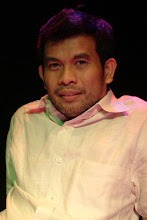Dancer/lecturer Zubin Mohamad’s passion for dance has taken him to foreign shores where he is doing what he loves to do most
MALAY contemporary dancer cum lecturer Zubin Mohamad is teaching dance at the University of California in the United States – something he is unable to do back home. He is there for a six-month stint under a Fulbright scholarship.
The 46-year-old dancer is also likely to put up performances in several cities in the US, including New York and San Francisco.
 |
Most Malay dances require your feet to touch the earth as
this creates a special spiritual bond between the dancer
and the earth." – ZubinMohamad |
Zubin had taught dance in two institutions in Malaysia but he ended up in departments that did not directly deal with dance.
"In one university, I was transfered to the theatre department and in the other, I was asked to give dance theory lessons," says Zubin, who has a PhD in Political Economy of Contemporary Arts (Malay Dance Theatre).
"I wanted to mould young minds. I wanted to do choreography. I wanted to be on the dance floor. But I was not given a chance to do this in my own country.
"But nobody can stop me from dancing as it is in my blood."
Zubin has won a few prestigious arts awards, such as the Asia Fellow Award in 2002, Unesco’s Artisan of Southeast Asia in 2000 and Rockefeller’s Southeast Asian Islamic Scholars Award 2003.
At the age of eight, he learnt zapin, a traditional Malay dance form, and at the age of 13, he picked up silat, a Malay art of self defence.
"My uncles are zapin dancers and silat experts," says Zubin, who was born and raised in Kelantan. "They also made drums. We performed at palaces and in front of royalty. Almost every wedding in Kelantan then had zapin and silat performances.
"But not any more. Things have changed. Now, people prefer to have Faizal Tahir (Malaysian Idol runner-up) singing at their weddings."
One can feel the disappointment in his voice when Zubin laments about Malay traditional dance forms not getting the proper recognition and respect they deserve.
Asked if tourism has given a new lease of life to the Malay dance forms, he replies: "Tourism has good and bad effects."
He says in Sarawak, "we’ve seen how tourism has revived some dying dance forms".
But, he points out, it has also led to some of these dance forms being simplified and commercialised to the extent that their real essence has disappeared.
"Sometimes, the tourism industry tends to emphasise more on costumes rather than the essence of the dance forms," he laments. "They’re more interested in glittering outfits and big head gears. Dancing is not about costumes only."
Zubin also dislikes the fact that some of the traditional dancers perform in sandals for tourists.
"Most Malay dances require your feet to touch the earth as this creates a special spiritual bond between the dancer and the earth," he says.
At the moment, he is doing research for a new project, which will touch on the Bujang Valley, an archaelogical site in Kedah, which has unearthed evidence of Hindu and Buddhist influences in the region.
"Malaysian historians have failed to tell us the truth," he says. "I’m sick and tired of people telling us that our country is very young. We’re not and our history didn’t start with the Malacca sultanate."
Some people are accusing Zubin of attracting unnecessary controversy by doing the Bujang Valley dance project.
"I’m not doing this for sensationalism," he insists. "I’m doing research on my culture and on my dance. We cannot deny that a lot of our art forms have Hindu and Buddhist influences. But they have gone through many Islamic transformation over the past century."
Being passionate about dance, he is frustrated that his home state of Kelantan has banned mak yong performances as the state government claims that it goes against certain Islamic teachings.
"There’s a lot of misconception about this dance form," Zubin says. "There should have been some kind of discussion before any decision was taken to ban mak yong."
SOUNDBITES
ON DANCE FORMS
"Dance should not be about looking beautiful and exotic. It should have some meaning and carry a message. You can give any message through dance – from corruption to terrorism. There’s always a message behind my dance. I never dance just to be beautiful and exotic."
THE KL FRINGE FESTIVAL
"I started this festival in 2007 to give young dancers a chance to become choreographers and to perform solo acts. It aims to add some excitement to the dance scene in Malaysia. The festival is held on April 28, which is also World Dance Day."
ON THE PRESENT DAY CHALLENGES
"One of the challenges I faced when I started the The KL Fringe Festival was when another organiser held a dance festival in the same month. To make matters worse, they stole dancers from my festival. Of course, they were bigger and had better resources. Their festival got better media coverage too but why did they want to compete with me? As artistes, we should be working together, not against each other."
